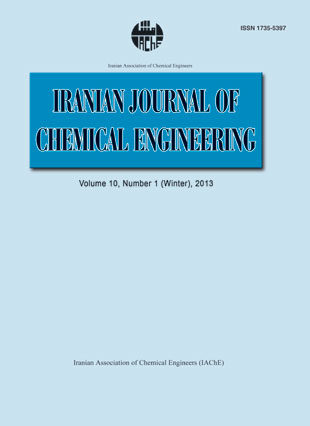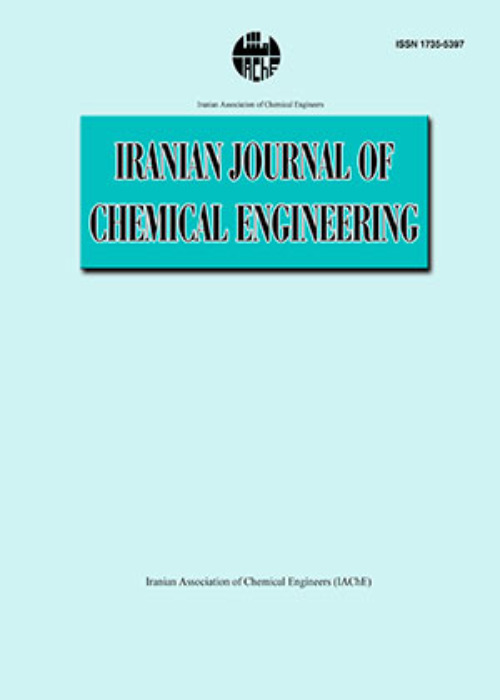فهرست مطالب

Iranian journal of chemical engineering
Volume:10 Issue: 1, Winter 2013
- تاریخ انتشار: 1393/01/10
- تعداد عناوین: 8
-
-
Pages 3-15The gelling of waxy crudes and the deposition of wax on the inner walls of pipelines present a costly problem in the production and transportation of oil. The object of the present study is to investigate the factors that affect the deposition of the paraffin wax on the pipe surface under different conditions using a flow loop system. A series of experiments on wax deposition from a mixture of waxy oil have been performed in a 65cm by 1cm ID flow loop in both laminar and turbulent flow regime. These experiments were done to study the effect of some important factors on the amount of deposited wax on the pipe wall. These factors consist of flow rate, residence time, wax concentration and temperature difference between mixture and pipe wall. It was found that the wax deposition increases with increasing temperature difference and residence time, but the effect of flow rate depends on flow regime. The other goal is mathematical modeling of wax deposition for a multi-component hydrocarbon mixture. The procedure for generating the model is described in detail. Finally, the results obtained from the model were compared with experimental data. It was found that there is an acceptable match between experimental and theoretical data and to some extent, this confirms the validity of the model and also the ability of the developed model to predict the wax deposition on pipelines under different operational condition.Keywords: Wax, Deposition, Mathematical Model, Pipeline, Flow Loop System
-
Pages 16-29This research work focuses on the performance optimization of composites containing both micron and nano size TiO2 particles separately in various concentrations and to understand the role of each on the thermal stability and moduli of the composites. Thermal stability of the particle-reinforced composites increased on increasing the concentration of TiO2, both in nano and micron filled cases, except for the 2.5 wt% nano-filled composite. Storage modulus (E') increased on adding micron-TiO2 to the epoxy hardener resin system from 1 - 2.5 - 5 wt% respectively and decreased dramatically on further increasing the micron TiO2 content to 7.5 and 10 wt% respectively. Nano TiO2 particle-reinforced composites showed an increasing trend of storage modulus for 2.5 - 5 - 7.5 wt% TiO2 filled composites with respect to the neat resin system. Presence of both micron and nano TiO2 particles increased the Tg of the composites. Also, the effect of sonication on the modulus and Tg is discussed. As a whole, composites in which the TiO2 particles were dispersed through the resin matrix by glass rod revealed better results (higher storage moduli and Tg) than those mixed by sonication, due to high viscosity of the epoxy resin used.Keywords: Polymer Matrix Composites (PMCs), Nano, Micron TiO2 Particles, Mechanical Properties, Ultrasonic, Thermal Analysis
-
Pages 30-44The coalescence of water droplets in oils may be enhanced by application of an electric field. This approach is commonly used in the crude oil and petroleum industry to separate water from crude oil extracted from oil well. By application of an electric field two patterns of drop-interface coalescence may occur: complete coalescence and partial coalescence. The former is obviously the desirable pattern for industrial coalescers. However in practice, the process of coalescence could actually produce smaller droplets which become more difficult to remove, and hence undesirable. This is caused by either necking, due to extensive elongation of the droplet, or reaction to a fast and energetic coalescence and is referred to as partial coalescence. The volume of the droplets formed in this way has been analyzed as a function of the initial droplet size, electric field strength and change in interface tension between two phases as a result of surface active agents. There is a considerable growth in secondary droplets volume. Expansion speed of the neck connecting the droplet and interface at the beginning of the pumping process has also been quantified and partial coalescence has been explained as a result of competition between pumping and necking processes. These results are useful in optimizing the electro-coalescence process.Keywords: Coalescence, Electric Field, Electro, Coalescer, Interfacial Tension, Pumping Process
-
Pages 45-54In this research, reactive absorption of hydrogen sulfide using diglycolamine solution in an industrial tray column was investigated. A nonequilibrium stage model has been developed based on dynamic film model for modeling of hydrogen sulfide reactive absorption into diglycolamine solution. In the model, simultaneous heat and mass transfer and reactions rate were considered. The model equations including partial and ordinary differential equations were solved numerically using the method of lines technique. The simulation results are presented in steady and unsteady state conditions. An industrial absorption column was employed to obtain the experimental data in both low and high pressure. The model results were evaluated using the steady state experimental data. A comparison of the experimental and simulation results showed that the average of correlation coefficient error for high pressure absorption process is 8.5 percent whereas the average of correlation coefficient error for low pressure absorption process is 7 percent.Keywords: Reactive Absorption, Nonequilibrium Modeling, Film Model, Hydrogen Sulfide (H2S), Diglycolamine (DGA)
-
Pages 55-66Flow behavior of gas and agglomerates is numerically investigated in the riser based on a transient two-fluid model. The gas phase is modeled by the LES model, and the solid phase uses a kinetic theory model developed from the molecular model coupling the gas-agglomerates interaction and the agglomerates-agglomerates interaction[1]. We assumed that the ultrafine particles move as natural agglomerates rather than single particles in the riser. The energy transfer and dissipation by the instantaneous collisions between the agglomerates of ultrafine particles and gas phase and between agglomerates-agglomerates are considered. The diameter of agglomerates is estimated based on the force model by Li and Tong[2].The distributions of velocity, concentration and diameter of agglomerates, are numerically obtained. The influence of flow and agglomerates in the different operating conditions is also analyzed. The results show that the large agglomerates are rich in the bottom section of the bed. Thus the Fast Fourier Tranform (FFT) is used to get the fluctuated character of the agglomerates in the riser and find the dominant frequency of the agglomerates fluctuation is 0.03-1.26Hz.Keywords: Ultrafine Particles, Agglomerates, Force Balance Method, Numerical Simulation, Power Spectrum Density
-
Pages 67-78In this study, simulation of cyclic adsorption process for mercaptan removal from natural gas in non-isothermal and non-adiabatic conditions is presented. This process is used in mercaptan removal unit of South Pars Gas Refinery Phase 1. Six adsorption fixed beds used in this plant contain molecular sieve type zeolite 13X. Three beds are in the process for adsorption purposes and the other three beds are being used for regeneration simultaneously. Regeneration cycle involves two steps for heating and one step for cooling. In modeling of this process, linear driving force (LDF) is used for estimation of adsorption rate. For equilibrium relation between solid and gas phases, the extended Langmuir isotherm is used. The energy balance around the gas phase in the bed includes heat transfer to solid as well as axial heat dispersion. The set of partial differential equations is solved using implicit finite difference. Cyclic steady state (CSS) is obtained using cyclic simulation procedure and the variation of concentrations and temperatures along the bed and at different times.A good agreement was obtained between the simulation results and those obtained from plant operational data. The effect of various operational parameters, such as regeneration steps, temperature and regeneration flow rate on process product was investigated. With increasing the first heating stage temperature, the concentration of water and mercaptan in the bed outlet decreases, but the decrease in mercaptan concentration is more significant. By increasing the second heating stage temperature, the water concentration in the bed outlet decreases significantly.Keywords: Simulation, Cyclic Adsorption Process, Mercaptan Removal, Cyclic Steady State, Non, isothermal
-
Pages 79-91The aim of this contribution is a survey of different nucleation and growth kinetics terms effects on modeling results of KNO3 Continuous Mixed Suspension Mixed Product Removal (CMSMPR) crystallizer. By studying the four different states in modeling, results show that, although these terms for similar crystallization system and operating conditions are similar, there is very different dynamic behavior in the results such as Particles Size Distribution (PSD), crystals mean size and relative supersaturation. The main difference in modeling results is oscillating behaviors. It is shown that such behavior strongly depends on kinetics terms sensitivity to supersaturation, especially in nucleation models.Keywords: Nucleation, Growth, CMSMPR Crystallizer, PSD, Oscillating Behaviors, Supersaturation
-
Page 92


